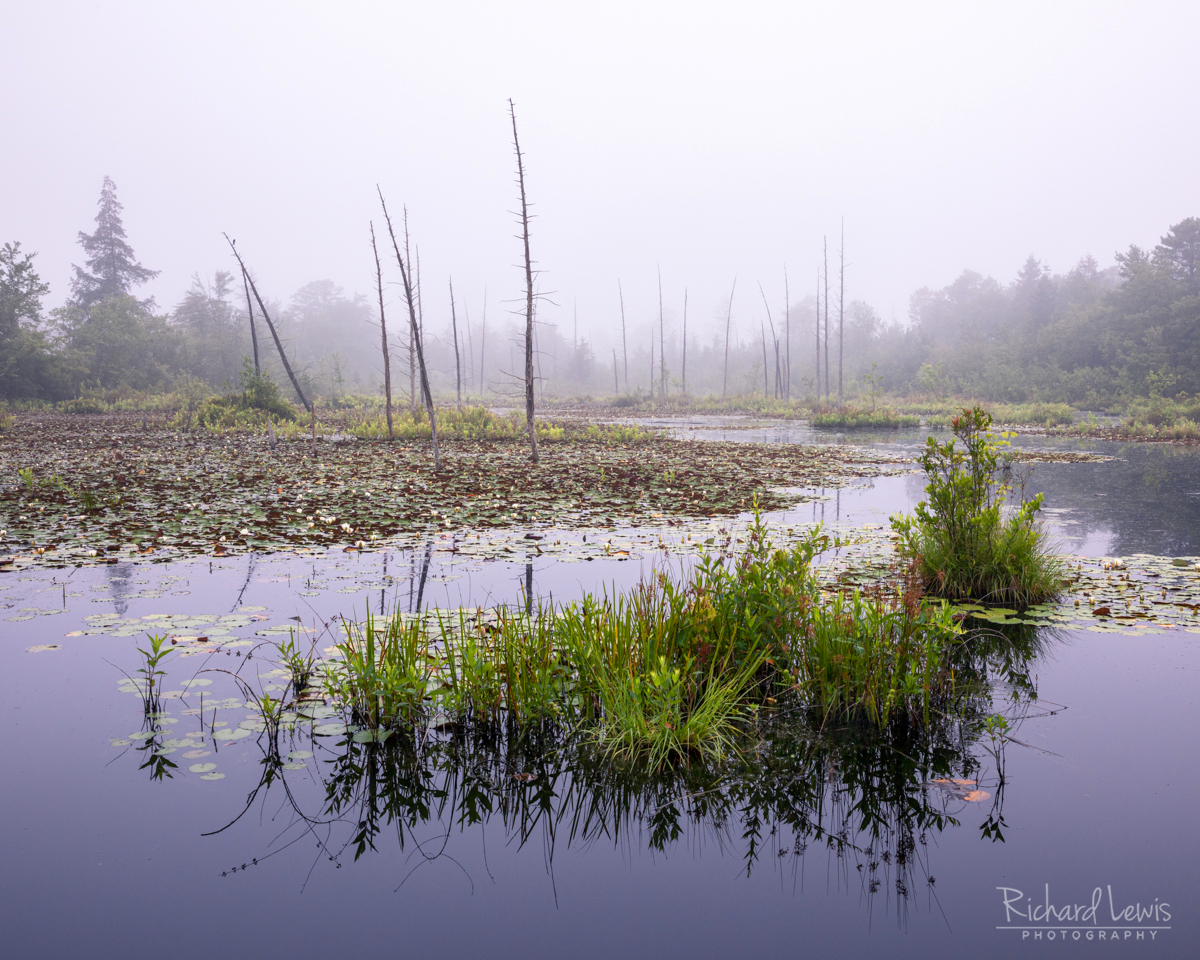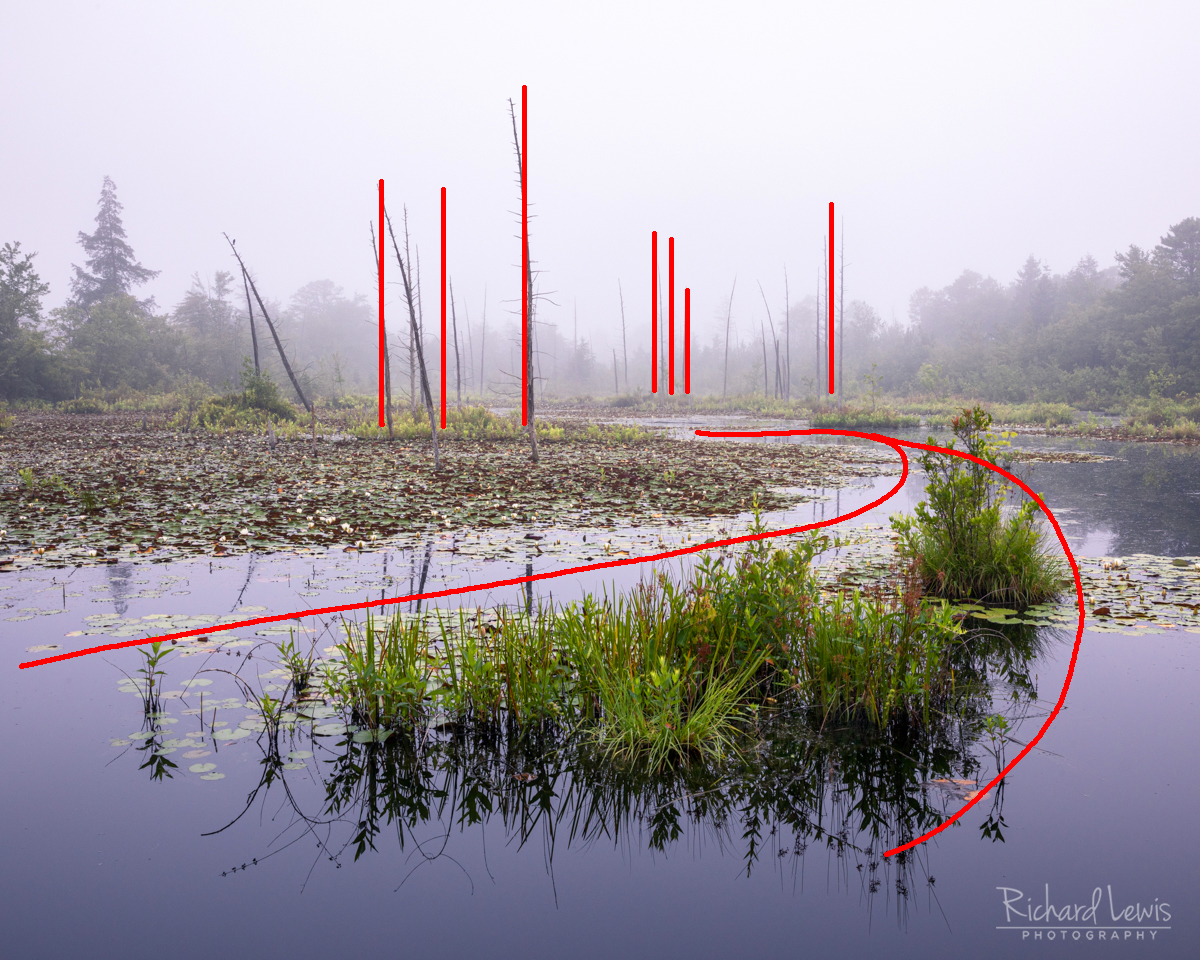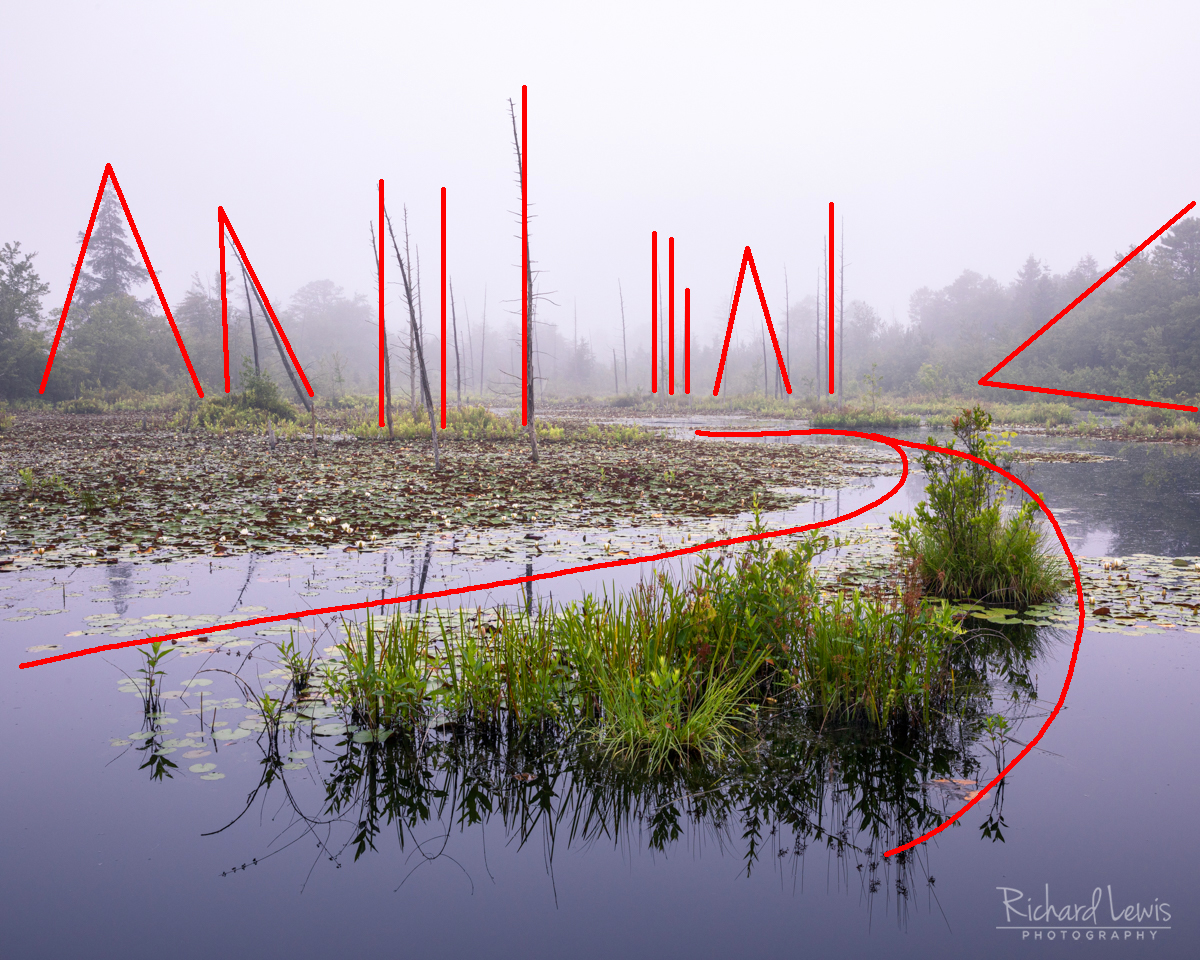Composition and the Art of Seeing
The New Jersey Pine Barrens are probably one of the most challenging places to photograph landscapes. Which means it is one of the best place to photograph landscapes. Why? Because the landscape is not obvious. I say this a lot, so forgive the repetition. The Pines are a flat sandy coastal plain with lots of hidden visual treasures. While we don’t have mountains or waterfalls, we do have subtlety and a landscape that will reveal unlimited beauty to someone who makes the effort to find it and learn to photograph it.
With this post I’ll tell a tale of two photographs. This will give you some tips on composing a photograph in the Pine Barrens and show you how to find the landscape within a landscape. Below is a detailed look at how I composed two photographs while standing in the same spot.
The Big View

Canon 5D Mark IV, 27-70mm lens @ 70mm .6 seconds @ f/16, ISO 400
Early one morning I headed out to photograph this spot in the fog. It was a photograph I’ve wanted to make for a long time, but was waiting for the right conditions before venturing out to the location. Mission accomplished. I got the photograph and am very happy with it. Below is the process I used to compose the image.
Many photography instructors encourage you to visualize your finished image before you set up your camera. That doesn’t always work for me. I usually like to show up to a place and then try to make sense of how to photograph it. It’s fun to discover the composition as I’m standing before the scene. Neither method is right or wrong, they are just different. The main thing I liked about this scene was the curve in the waterway. Curves can be powerful elements in a composition. In this case it brings you into the background.

A photograph that has as much detail as this one shouldn’t just have an element that leads the viewer into the scene, it also needs some visual tools for the eye to wander around the scene. In this case, the stand of dead cedar trees is one of the main features of this image that I want the viewer to enjoy. What makes them enjoyable is the fact that they create abstract repeating patterns that are pleasing to the eye and work to hold the eye in the photograph.

But wait, there’s more. There are several elements that create triangles which are very powerful compositional elements. Leaning trees, that beautiful pine tree on the left and even the edge of the forest on the right all create triangles that, along with the other elements, help to keep the viewer engaged with the photograph.

All of these compositional elements are pretty much worthless if you don’t have the basics. In this case, it was the fog and subdued light that creates the mood and gives the image its purpose. One final thought about this photograph is that by having the eye explore the detail, the viewer is encouraged to discover things that might not be noticed with a quick glance. In this scene, besides the water lilies starting to open, there are some nice reflections, but my favorite little detail is this bird. It remained perched here throughout the thought process needed to compose this image.

The Close View

Canon 5D Mark IV, 70-200 lens @ 97mm, .4 seconds @ f/22 ISO 400
Even though I made the first photograph, it is always a good idea to challenge yourself to keep looking and trying to find something else in the scene. In this case, it was finding the landscape within the landscape. I really love the abstract environmental art the dead cedar trees create. These groves of dead trees which were killed by rising water levels caused by the changing environment, humans and beavers, are like an organic sculpture garden. They create the same repeating shapes as the first photograph, but here they intentionally dominate the scene.

But this composition has something more. The diagonal line created by the waterway and the tops of the trees, as well as the lean of some of the trees, created a visual path for the eye in the image.

Finally, as if to say it approved, the bird decided to fly to a new perch and be a tiny treat in this image as well.

I hope this post encourages you to challenge yourself as a photographer. These two photographs made under different light or without creating a path through the image to guide the eye would have just been mediocre pictures of a bog.
This is why I love the Pine Barrens. It doesn’t just challenge, but it forces you to find the beauty and figure out how to share that beauty with anyone viewing your photograph. It is the reason I only lead workshops in the Pines. I want photographers not just see the unique beauty of this special place, but to learn to build a composition where it may not be obvious and then take that lesson along with every photo outing they go on–no matter where it is.
Enjoy!
Find out more about my workshops here

It’s amazing how much thought goes into a ‘simple’ photograph. This was a great breakdown of details!
Thanks Jason. We live in an area that composition doesn’t usually come without a working the scene to create an artistic composition. I think it is why Pine Barrens photographers tend to excel at this craft. If you can work here, the iconic spots become pretty easy.
Enjoyed your presentation on simplifying composition out of a chaotic landscape. Very informative and easy to understand, much appreciated.
Thanks Jay. Composition in our sometimes chaotic Pine Barrens Landscape can be a challenge. We don’t always have a point and shoot landscape.
This was really helpful Rich. I think every workshop I’ve been on with you, you’ve challenged us to make sense of the chaos as we work on our composition. I’ve seen other photographers do as you did…showing leading lines, flow, shapes etc that draw the viewer into the photo. My question is…are you thinking about all that out in the field as you’re composing the shot…are you analyzing the scene for those necessary elements, or is it more of an intuitive process for you? Not sure my question makes sense but I guess what I’m really asking is…is this a ‘head’ thing or a ‘feeling’ thing? Thanks again…still looking forward to October!
Thanks Jan for your really nice compliment. Making sense of the chaos is the perfect training for a photographer. If you can photograph the Pine Barrens, the rest is easy.
To answer your question is kind of difficult because my thought process in composing an image varies. Sometimes it’s spending the time refining the composition (It’s why I love a tripod) sometimes it is more instinctual. I think those instincts come from having experience and learning to trust your creativity. It is important is to not second guess yourself. If you go with what you feel when taking a photograph, you will probably find that that is the image you end up loving. I hope that helps. See you soon.
Thank you for the detail analysis of the two photograph. I love water lilies, so I would love to experience the blooming of wild , not cultivated water lily scene. would you share this beautiful spot with me? My email is mannageist@gmail.com Thank you for all the blogs.